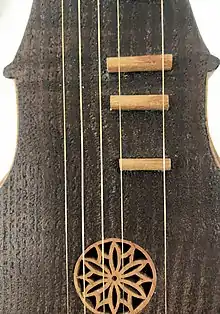Sato (instrument)
The Sato is a bowed tanbur, or long-necked lute, played by performers of Central Asian classical and folk music, mainly in Uzbekistan and Tajikistan.[1] It has five strings. When plucked, the top string is pressed to the neck to produce a melody; the other four strings are drone strings.[1] Frets on the neck are made of tied string.[2] The soundboard has holes drilled in it for sound holes.[2] It is made from mulberry wood.[2]


Famous Uzbek musician Turgun Alimatov is solely responsible for reviving the art of playing the Sato, as it had completely disappeared for a number of centuries before he took it up in 1957. Thus he has been considered as the founder of the Sato and its playing style and technique.[3][4] Professor Abduvali Abdurashidov is the foremost teacher of Sato and composer of the art of Shash Maqom (also called Shashmaqam) in Tajikistan.
_held_up_to_illustrate_relative_size._01.jpg.webp)




References
- "Instruments". akdn.org. Aga Khan Development Network. Retrieved 12 October 2016.
- Green, Todd. "String Instruments, Sato (Uzbekistan)". toddgreen.com. Retrieved 12 October 2016.
- Matyakubov, O. "A Traditional Musician in Modern Society: A Case Study of Turgun Alimatov's Art". Yearbook for Traditional Music 25 (1993), pp. 60-66.
- https://shahnameh.netlify.com/sato.htm The Shahnameh Guide To The Lutes Of Central Asia